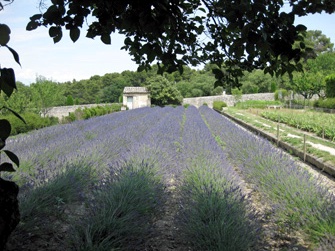
After Paris, Provence is probably the most famous part of France, known for its stunning landscapes, its quaint villages, its fragrant plants, its chirpy cicadas and its year. By the latter I refer, of course, to a certain blockbuster book by a certain bestselling writer whom I shall not identify other than to say that his initials are “P.M.” and the other letters in his name are “E-T-E-R” and “A-Y-L-E.”
I am not personally a Mayle fan, although I do not in any way begrudge him his success. And I suspect that many residents of Ménerbes, the village where he spent his now legendary 366 days (it was a leap year), would share my point of view. Provence is full of lovely medieval villages, and when we’re in the region, my wife and I like to rent a house in one of them (this year our choice was Saignon) and make the rounds of the others, including Bonnieux, Lacoste, Gordes, Goult, Roussillon and Monsieur Mayle’s Ménerbes. I have been to Ménerbes on several occasions over the past decade or so, and the place looks noticeably more prosperous every time. I didn’t check this with the Chamber of Commerce, but it looks to me like the tourism generated by You-Know-How-Long in You-Know-Where has brought a steady flow of non-Provençal cash into town. The buildings are all fixed up nicely, the stores all seem to be thriving, there’s a big new parking lot, and, when we were there in June, they had just finished repaving the streets with little smooth beige-colored squares that looked like (but I’m sure are not) slabs of marble.
So I did a little calculation: I figure that if Mayle’s multi-million-dollar book and its sequels and spinoffs can yield enough revenue to make that much improvement, then the next time I go to Ménerbes I should see a tiny upgrade in the infrastructure thanks to my mentioning the town in this column. Perhaps a new “Private Property-No Photos” sign or an extra strip of flypaper in the public toilet by the bus stop.
Of course, the estimable Mr. M is not the only well-known figure in the arts who has spent time in Provence. The region is also the former stomping grounds (in one case literally) of Nobel-winning poet Frédéric Mistral, classic author Alphonse Daudet, Post-Impressionist painter Paul Gauguin, and evil horndog (and novelist!) the Marquis de Sade.
The man whose name became half of an often-abbreviated perversion used to own a castle in the picturesque hilltop village of Lacoste, where he would retreat from time to time when the humdrum routine of debauchery and orgies in Paris was getting on his nerves, making him want to lash out. Lacoste is quite a small town and doesn’t have any other historical celebrities to brag about — unless you count the castle’s current owner, Pierre Cardin — so the locals are actually quite proud that the old stud bucket used to live there. They now have a (no kidding) Café de Sade, a (no kidding) De Sade Newsstand and a (kidding) De Sade Dental Clinic. Right next door to the Marquis de Sade Anger Management Counseling Center.
But on the backroads of Provence, the memory of the malevolent marquis pales in comparison with the more recent, and decidedly more masochistic, legacy of Vincent Van Gogh. One of our stops on this trip was the Saint Paul de Mausole psychiatric hospital in Saint Rémy de Provence, where the Dutch painter was confined (at his own request) for a year in this room:
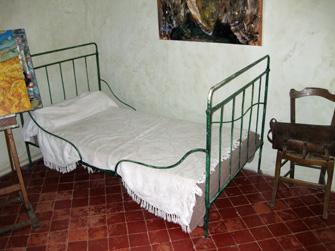
Before checking into Saint Paul, Van Gogh had been living in nearby Arles, where he found his life spinning out of control due to a variety of factors that included what one source I consulted refers to as “overindulgence in coffee and alcohol, especially absinthe, poor eating habits and periodic attempts to consume turpentine and paint.” Consuming turpentine and paint — yes, I think that would qualify as poor eating habits. It was also at this time that Van Gogh developed poor not-cutting-your-own-ear-off habits. All of this made the asylum seem like an attractive option.
At the entrance to Saint Paul de Mausole, just to remind you that it is to this day a working mental health institution, the first thing you see is this:
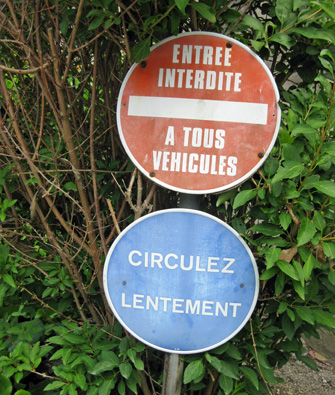
Sadly, Van Gogh did not make a painting of those signs (I can’t imagine why) but he did paint his room, a great many views of the grounds, quite a few scenes inside the hospital and even a handful of portraits of the people he met there. In all he produced 143 paintings in his 57 weeks at Saint Paul, including two of his most famous works, “The Starry Night” and “Irises.” That’s more than one completed canvas every three days. What explains this flood of creative energy? I think I have the answer.
It turns out that the main form of treatment for the patients at Saint Paul at that time was “hydrotherapy,” which essentially meant long cold baths. So instead of group and couch sessions, Van Gogh was expected to take hour-long icy soaks in non-private tubs like these:
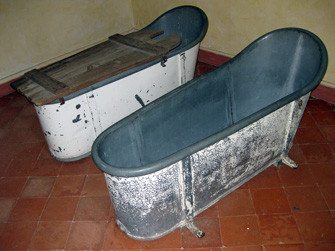
Picture it: Vincent Van Gogh, a visionary painter who’s just starting to get some attention on the art scene, is working away at his easel when he hears the nurse calling:
“Mr. Van Gooooogh! Time for your bath!”
“Oh yeah, ahh, right… Hey, just leave the door unlocked, and I’ll hop in as soon as I finish up with these sunflowers, okay?”
“Now, Mr. Van Gogh, that’s what you said yesterday, and when I checked later you hadn’t been anywhere near that tub.”
“Look, give me a break on the hydro-crapola and I’ll change my will to cut you in for 10 percent of the future auction prices of my paintings.”
“Just me or all of my descendants?”
“Call me crazy, but all right, your descendants too.”
“In perpetuity?”
“How about through 1999?”
“Deal. I’ll go get you another canvas.”
Just as Lacoste is De Sade-obsessed, the town of Saint Rémy is Van Gogh-obsessed. You see reproductions of his paintings and mentions of his name everywhere. I think it’s a little excessive. And I suspect — in fact I’m sure — that many residents of Saint Rémy share my point of view. I say this with certitude because of a plaque I saw on a building in the Old Town:
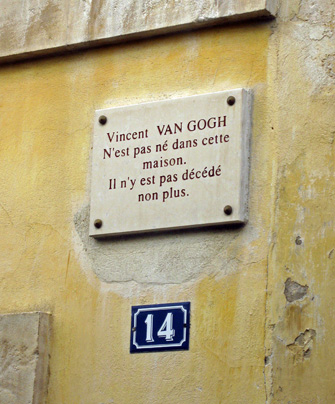
I bet he never took a cold bath there either.
© 2011 Paris Update
FavoriteAn album of David Jaggard’s comic compositions is now available for streaming on Spotify and Apple Music, for purchase (whole or track by track) on iTunes and Amazon, and on every other music downloading service in the known universe, under the title “Totally Unrelated.”
Note to readers: David Jaggard’s e-book Quorum of One: Satire 1998-2011 is available from Amazon as well as iTunes, iBookstore, Nook, Reader Store, Kobo, Copia and many other distributors.
